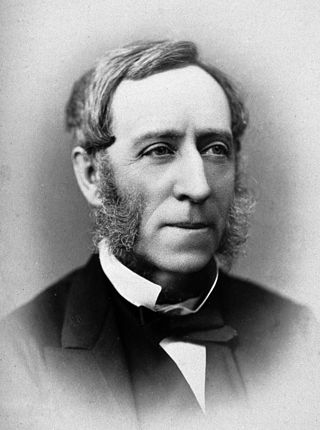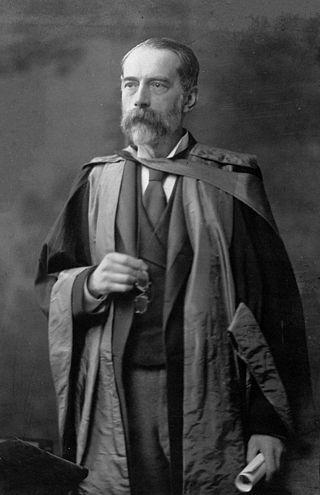
Thomas Graham Balfour (18 March 1813 – 17 January 1891) was a Scottish physician noted for his work with medical statistics, and a member of Florence Nightingale's inner circle.

Thomas Graham Balfour (18 March 1813 – 17 January 1891) was a Scottish physician noted for his work with medical statistics, and a member of Florence Nightingale's inner circle.
Balfour was born in Edinburgh on 18 March 1813. He was son of John Balfour, a merchant of Leith, and his wife Helen, daughter of Thomas Buchanan of Ardoch. He was the great-grandson of James Balfour, professor of moral philosophy at Edinburgh in 1754, and of Robert Whytt, a celebrated medical writer and professor of physiology at Edinburgh. He graduated MD at Edinburgh in 1834; FRS, 1859; Surgeon-General, Honorary Physician to Queen Victoria and compiler of the first four volumes of Statistics of the British Army. [1] According to Francis de Chaumont, the publication of this statistical work "marked an epoch in hygiene". [2]
The Statistics of the British Army were reputed to be the most accurate and complete of their sort throughout Europe. [3]
From 1840 to 1848, Balfour served as assistant surgeon in the Grenadier Guards. In 1857 he was appointed secretary to Sidney Herbert's committee on the sanitary state of the army, and in 1859 he became deputy inspector-general in charge of the new statistical branch of the army medical department, a post which he held for fourteen years. He was elected a Fellow of the Royal Society on 3 June 1858, and in 1860 a fellow of the Royal College of Physicians of London. [1]
He along with Dr John Sutherland were secretaries to the Sanitary Section of the International Statistical Congress in 1860, which was attended by Adolphe Quetelet, and to which Florence Nightingale submitted a paper.
In 1887 he was appointed honorary physician to the queen. He was placed on half-pay as surgeon-general in 1876, and in his forty years of service had done much to improve the sanitary condition of the forces. He was President of the Royal Statistical Society from 1888 to 1890 shortly after it had changed from the Statistical Society of London. [4] He married in 1856 Georgina, daughter of George Prentice of Armagh, and had one son, Sir Graham Balfour. He died at Coombe Lodge, Wimbledon, on 17 January 1891. [1]

The Dean Cemetery is a historically important Victorian cemetery north of the Dean Village, west of Edinburgh city centre, in Scotland. It lies between Queensferry Road and the Water of Leith, bounded on its east side by Dean Path and on its west by the Dean Gallery. A 20th-century extension lies detached from the main cemetery to the north of Ravelston Terrace. The main cemetery is accessible through the main gate on its east side, through a "grace and favour" access door from the grounds of Dean Gallery and from Ravelston Terrace. The modern extension is only accessible at the junction of Dean Path and Queensferry Road.

Sir Gilbert Blane of Blanefield, 1st Baronet FRSE FRS MRCP was a Scottish physician who instituted health reform in the Royal Navy. He saw action against both the French and Spanish fleets, and later served as a Commissioner on the Sick and Wounded Board of the Admiralty.

Sir Richard Quain, 1st Baronet, was an Irish physician.
Physician to the King is a title held by physicians of the Medical Household of the Sovereign of the United Kingdom. Part of the Royal Household, the Medical Household includes physicians, who treat general conditions, and extra physicians, specialists who are brought in as required.
Sir Francis Martin Rouse Walshe, FRS was a British neurologist.
Sir James Fellowes FRS FRSE FRCP was a British military physician. He became head of the British Army's medical staff in the Peninsular War, and was also literary executor to Hester Thrale.
The Wernerian Natural History Society, commonly abbreviated as the Wernerian Society, was a learned society interested in the broad field of natural history, and saw papers presented on various topics such as mineralogy, plants, insects, and scholarly expeditions. The Society was an offshoot of the Royal Society of Edinburgh, and from its beginnings it was a rather elite organization.

Henry John Carter, FRS was a surgeon working in Bombay, India, who carried out work in geology, paleontology, and zoology. He worked as an army surgeon in Bombay from 1859 on Her Majesty's Indian Service, Bombay Establishment. He edited a collection of geological papers on Western India, including a summary of the geology of India, which was published in 1857. Many items of his published work appeared in the journal of the Bombay Branch of the Royal Asiatic Society, and in the Annals of Natural History. He was elected a Fellow of the Royal Society in 1859.

Sir William Tennant Gairdner was a Scottish Professor of Medicine in the University of Glasgow.

David Douglas Cunningham was a Scottish medical doctor and researcher who worked extensively in India on various aspects of public health and medicine. He studied the spread of bacteria and the spores of fungi through the air and conducted research on cholera. In his spare time he also studied the local plants and animals.

Sir Thomas Richard Fraser was a British physician and pharmacologist. Together with Alexander Crum Brown he discovered the relationship between physiological activity and chemical constitution of the body.

Sir Thomas Grainger Stewart was an eminent Scottish physician who served as president of the Royal College of Physicians of Edinburgh (1889–1891), president of the Medico-Chirurgical Society of Edinburgh, president of the medicine section of the British Medical Association, and Physician-in-Ordinary to the Queen for Scotland. He was perhaps best known for describing the condition known as multiple neuritis as well as directing scientific attention in Great Britain to the deep reflexes.

Surgeon General George BidieCIE was a British physician who worked in India in the Madras Medical Service. He was also Superintendent of the Government Museum, Chennai from 1872 to 1885.

Daniel John Cunningham, was a Scottish physician, zoologist, and anatomist, famous for Cunningham's Text-book of Anatomy and Cunningham's Manual of Practical Anatomy.

George William Balfour FRSE was a Scottish physician, known as a heart specialist.

Surgeon Major Francis Stephen Bennet François de Chaumont was a British Army surgeon.
Sir Henry "Harry" Letheby Tidy was a British physician and gastroenterologist.
Colonel Sir Robert Hammill Firth, was a British Army surgeon, tropical medicine specialist, and professor of military hygiene.
![]() This article incorporates text from a publication now in the public domain : Moore, Norman (1901). "Balfour, Thomas Graham". In Lee, Sidney (ed.). Dictionary of National Biography (1st supplement). London: Smith, Elder & Co.
This article incorporates text from a publication now in the public domain : Moore, Norman (1901). "Balfour, Thomas Graham". In Lee, Sidney (ed.). Dictionary of National Biography (1st supplement). London: Smith, Elder & Co.